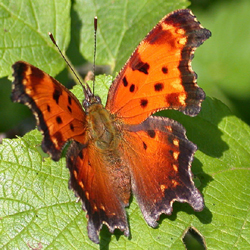Find a Butterfly
Gray Comma
Polygonia progne
Named
Cramer, 1776

Identification
Wingspan: 1 5/8-1 7/8". The Gray Comma may be told from all the other anglewings by its grayish underwing color and tapered, L shaped, unbarbed "comma" mark on the hindwing beneath. Two forms of the Gray Comma are recognized. The summer form has wide dark borders above and is more uniformly colored below; the fall form is lighter above, with minimal black spotting, and is more two toned beneath.
Distribution
British Columbia east across Canada to the Gaspe Peninsula and Nova Scotia; south to Wyoming, Kansas, Missouri, and North Carolina. In New England, occurs primarily in northern and western regions.
Status in Massachusetts
In 1889, Scudder wrote of the species: "In New England it is more generally distributed and universally common than any other species of the genus, but is somewhat more abundant in the southern half than in the northern parts." Today, the situation in southern New England is apparently drastically different than in Scudder‘s day. In Massachusetts, the Gray Comma is an uncommon to rare resident of deciduous and mixed woodlands, primarily in western Massachusetts. The scant eastern Massachusetts records include Martha‘s Vineyard (Dukes Co.) on 11 and 13 September 1939 (Kimball and Jones, 1943); Concord (Middlesex Co.) 9 July 1978 (B. Cassie); and Hopkinton (Middlesex Co.) (2) 13 April 1981 (Tom Franks). During the Atlas period, all state records were procured from Berkshire County. Maximum: 2

Flight Period in Massachusetts
Three flights, typically from late June to mid August and late September to mid October, with second generation individuals overwintering to fly the following spring from late March to early June. Extreme dates: "middle of March" and "middle of October" (both Scudder, 1889).
Larval Food Plants
Wild Gooseberry (Ribes rotundifolium) is the principal larval food source. Pink Azalea (Rhododendron nudiflorum) and elm (Ulmus, species) are used rarely.
Adult Food sources
Gray Commas are primarily attracted to rotting fruit and sap. They only occasionally visit flowers for nectar.

Habitat
Deciduous woodlands, especially in sunny clearings and along roads.
Life Cycle
EGG: Pale green; dome shaped and ribbed. OVIPOSITION: Eggs laid singly on host leaf. LARVA: Variably colored and spiny. CHRYSALIS: Variegated, angular, and tuberculated. OVERWINTERING STAGE: Adult.
Gray Commas appear in the spring, primarily from April to May. Sunlit tree trunks and rocks provide ideal perches. The summer generation emerges about the first of July, occasionally earlier. The eggs of this generation are laid in late July and the adults begin to emerge in late August. The species flies until the advent of cool weather in October, when it seeks hibernating quarters.
Account Author
Ed Neumuth



